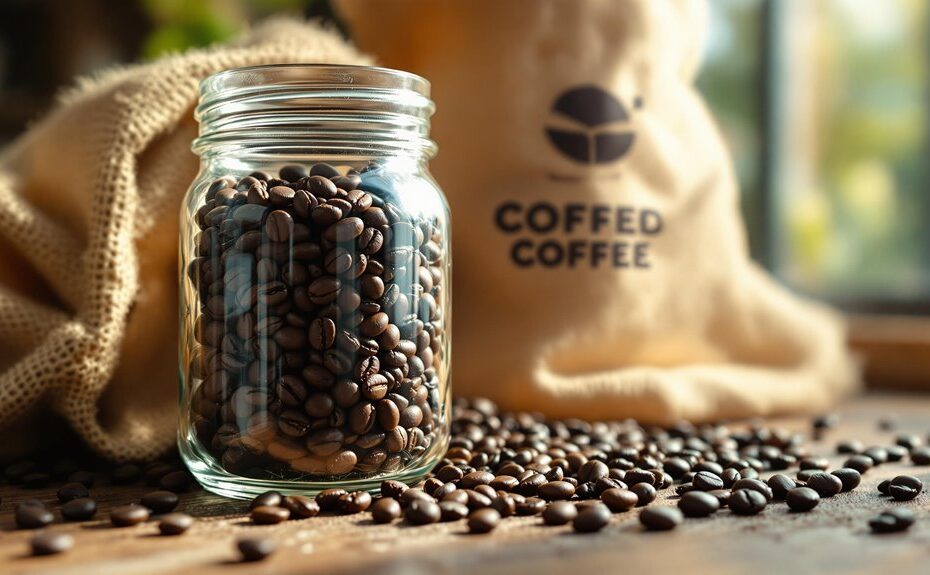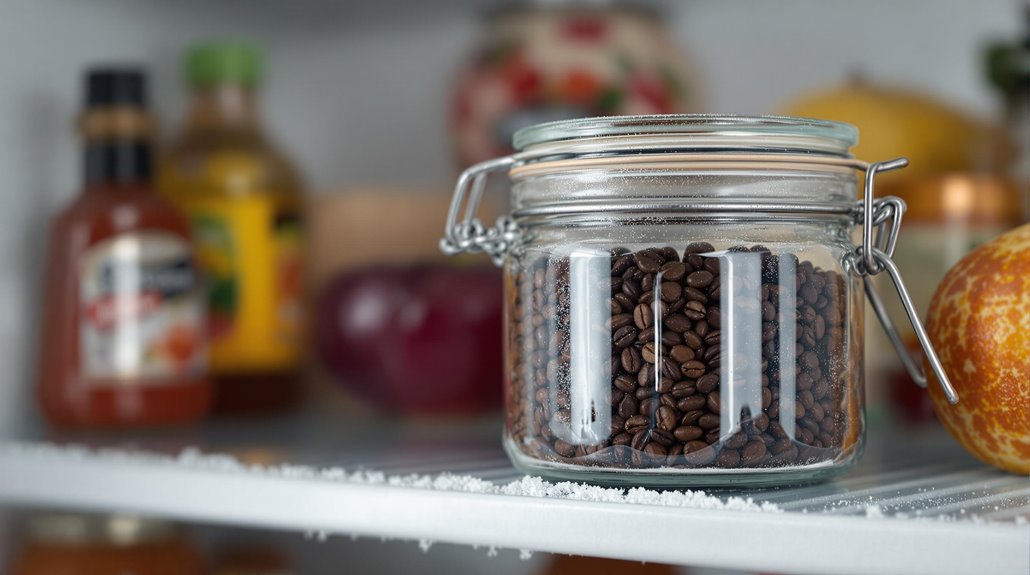







Storing coffee beans properly is key to preserving their flavor and aroma, but it's not as simple as tossing them in a cupboard. You'll want to avoid air, moisture, light, and heat, which can all degrade your beans faster than you'd expect. While airtight containers and cool, dark spaces are a good start, there's more to ponder—like whether freezing your beans is a smart move or a recipe for disaster. The choices you make now can drastically impact your coffee's freshness, but the real question is: are you doing it right? Let's break it down.
Key Takeaways
- Store coffee beans in an opaque, airtight container at room temperature (60-75°F) to prevent oxidation and preserve freshness.
- Use containers with one-way valves to allow carbon dioxide to escape while keeping oxygen out, maintaining optimal storage conditions.
- Keep beans in a cool, dark place, away from heat, sunlight, and moisture, to avoid flavor degradation and staleness.
- Freeze beans in small, airtight, vacuum-sealed portions for long-term storage, but avoid repeated thawing and refreezing to prevent condensation.
- Consume beans within 2-4 weeks post-roast for peak freshness, and grind only what you need immediately before brewing.
Optimal Storage Conditions for Coffee Beans
To preserve the flavor and freshness of your coffee beans, you'll want to store them in an opaque, airtight container at room temperature, ideally between 60-75°F (15-24°C). This temperature range minimizes the risk of heat-induced degradation while preventing condensation from forming inside the container. Choose an air-tight container with one-way valves, which allow carbon dioxide—a natural byproduct of freshly roasted beans—to escape without letting oxygen in. Oxygen exposure accelerates oxidation, leading to stale flavors. Avoid using clear canisters or placing your container near heat sources like ovens or sunny windows, as light and warmth can degrade the beans' quality.
Transfer your coffee beans from their original packaging to the air-tight container immediately after opening. Retail bags often lack proper seals and aren't designed for long-term storage. Keep the container in a cool, dark place, such as a cupboard or pantry, to shield the beans from temperature fluctuations and light exposure. By following these steps, you'll maintain the beans' freshness and guarantee each brew delivers the rich, complex flavors you expect. Proper storage is key to extending the shelf life and preserving the quality of your coffee beans.
Impact of Air, Moisture, and Light on Freshness
Over time, air, moisture, and light can substantially degrade the freshness of your coffee beans. Oxygen exposure is one of the primary culprits, as it causes oxidation, leading to stale flavors and aroma loss. To combat this, minimize your beans' contact with air by storing them in airtight containers. Moisture is equally damaging; coffee is hygroscopic, meaning it absorbs water and odors from the environment. High humidity levels above 60% can accelerate staling and even promote mold growth, ruining your coffee quality. Keep your beans in a cool, dry place to prevent moisture absorption. Light, particularly direct sunlight, breaks down the delicate compounds in coffee, resulting in a loss of vibrant flavors. Store your beans in opaque containers or in a dark cupboard to shield them from light exposure. By controlling these factors—oxygen exposure, moisture, and light—you'll preserve the freshness, aroma, and flavor of your coffee beans, ensuring a better brewing experience.
Freezing Coffee: Pros, Cons, and Best Practices
Freezing coffee beans can preserve their freshness for up to a month, but you must use airtight, vacuum-sealed containers to block moisture and odors. Avoid thawing and refreezing repeatedly, as condensation can harm the beans and alter their flavor. For best results, freeze beans in small, single-use portions and let them reach room temperature before opening to prevent moisture buildup.
Freezing Coffee Benefits
Storing coffee beans in the freezer can be a game-changer for preserving their freshness, especially if you've bought in bulk or want to extend their shelf life. When you freeze beans, you slow down oxidation and minimize exposure to moisture, which are key factors in maintaining their flavor and aroma. To keep your beans fresh, transfer them into an airtight, vacuum-sealed bag or container before placing them in the freezer. This prevents air and moisture from degrading the beans over time.
For best results, freeze only the amount you won't use immediately, as repeated thawing and refreezing can compromise quality. When you're ready to brew, let the beans reach room temperature before opening the bag to avoid condensation, which can affect flavor. Freezing is particularly effective for specialty or bulk coffee, allowing you to store it for several months without significant loss of freshness. By following these steps, you'll guarantee your beans stay fresh and flavorful, ready to deliver a perfect cup whenever you need it.
Potential Freezing Risks
While freezing coffee beans can help preserve freshness, it's not without risks. One major concern is condensation, which occurs when you thaw frozen beans. As moisture forms on the surface, it can seep into the porous structure of the beans, leading to flavor degradation and a loss of aromatic complexity. Additionally, coffee beans are highly absorbent and can pick up odors from your freezer, altering their natural taste profile. If your beans aren't vacuum-sealed or tightly packaged, they're also at risk of freezer burn. This happens when air reaches the beans, causing them to dry out and lose their essential oils, resulting in a stale, flat flavor. Frequent freezing and thawing can further accelerate the aging process, making the beans less vibrant over time. To mitigate these risks, always use airtight, vacuum-sealed containers and freeze beans in small, single-use portions. Avoid repeatedly exposing them to temperature fluctuations, as this can compromise their quality. By understanding these potential pitfalls, you can make informed decisions about freezing your coffee beans.
Best Freezing Practices
Coffee's freshness can be preserved through freezing, but it requires careful handling to avoid compromising its quality. When storing coffee in the freezer, always use whole beans and divide them into small, airtight, vacuum-sealed portions. This prevents condensation and protects the beans from absorbing odors. Label each portion with the date to track freshness. Before freezing, make sure your beans are fresh and high-quality, as freezing won't improve poor beans.
To keep your beans fresh, avoid frequent thawing and refreezing, as this introduces moisture and degrades flavor. When you're ready to use frozen beans, let them thaw to room temperature while still sealed to prevent condensation. Once thawed, use them immediately and don't refreeze.
Freezing is best for storing beans in bulk or preserving special roasts, not for everyday use. For daily brewing, store beans in a cool, dark place in an airtight container. By following these best practices, you'll maintain the integrity of your coffee and enjoy its full flavor profile.
Freshness Timeline and Degassing
After roasting, coffee beans go through an essential degassing phase, where carbon dioxide naturally escapes. This process is key for achieving peak freshness, as it prevents bitterness and guarantees balanced extraction during brewing. For filter brews, beans are at their best between 2 days and 4 weeks post-roast, while espresso beans maintain top flavor for 1 to 6 weeks post-roast. Darker roasts require longer degassing periods than lighter roasts due to their higher carbon dioxide content. Always check the "Roasted on" date printed by the roaster to gauge freshness, and aim to consume your beans within 2-4 weeks of this date for the best results.
To keep your beans fresh during degassing, store them in an airtight container at room temperature, away from light, heat, and moisture. Avoid freezing or refrigerating them during this phase, as it can disrupt the degassing process. The flavor of your coffee will evolve noticeably from 1 day post-roast to about 2 weeks, with subtle changes continuing for up to a couple of months. By understanding the degassing timeline and storing your beans properly, you'll preserve their peak freshness and enjoy a consistently great cup.
Common Storage Mistakes and Maintenance Tips
Avoid storing coffee beans in your grinder hopper, as this exposes them to air and leads to staleness and oil buildup. Clean your grinder regularly to prevent residue from affecting flavor, and always grind beans just before brewing to maximize freshness. Pre-ground coffee loses its aromatic compounds quickly, so grinding on demand guarantees the best taste.
Avoid Grinder Hopper Storage
Storing coffee beans in your grinder's hopper might seem convenient, but it's a surefire way to compromise their quality. Grinder hoppers expose beans to air and humidity, accelerating staleness and flavor degradation. Over time, oils from the beans accumulate in the hopper, turning rancid and tainting the taste of freshly ground coffee. This oil buildup not only affects freshness but also leads to inconsistent grind quality, which can ruin your brewing results. To maintain peak flavor and performance, avoid leaving beans in the hopper for extended periods. Instead, transfer them to an airtight container immediately after grinding. This preserves their freshness and prevents exposure to environmental factors that degrade their quality. Coffee shops empty and clean their grinder hoppers nightly to avoid these issues, and you should adopt the same practice at home. By storing your beans properly, you'll guarantee they retain their aromatic oils and complex flavors, delivering a superior cup every time. Remember, the hopper is for grinding, not storage—keep your beans fresh by using an airtight container instead.
Clean Grinders Regularly
Keeping your grinder clean is just as important as storing your beans properly. To maintain grind consistency and prevent stale grounds from affecting flavor, clean grinders weekly. Start by unplugging the grinder and disassembling it to access the burrs and grind chambers. Use a stiff brush to remove coffee residue from the burrs, making sure no old grounds remain. Avoid using water or cleaning solutions on the burrs, as moisture can cause rust or damage. Wipe down the grind chambers thoroughly to eliminate any lingering oils or particles that could impact your coffee's taste. Reassemble the grinder carefully, making sure all parts are dry and properly aligned. Don't forget to wipe the exterior and hopper to prevent dust or contaminants from entering the grinder. Regular maintenance not only preserves the grinder's performance but also guarantees your coffee retains its freshness and quality. By incorporating these steps into your routine, you'll avoid buildup and enjoy a consistently clean grind every time.
Grind Beans Before Brewing
For the freshest cup of coffee, always grind your beans just before brewing. Pre-ground coffee loses its freshness rapidly because the increased surface area accelerates oxidation, diminishing flavor and aroma. To preserve the integrity of your coffee beans, invest in a burr grinder, which guarantees a consistent grind size. This consistency is vital for ideal extraction during brewing, enhancing the overall flavor profile of your coffee.
Avoid grinding more coffee than you need for a single brew. Excess ground coffee is exposed to air and moisture, which degrade its quality quickly. Store whole coffee beans in an airtight container away from light, heat, and humidity to maintain their freshness until you're ready to grind. By grinding only the amount required for each brew, you minimize unnecessary exposure and maximize the flavor and aroma of your coffee.
Original Packaging and Airtight Storage
When it comes to preserving the freshness of your coffee beans, the original packaging is often your best bet. Many coffee bags come equipped with one-way gas-release valves that allow carbon dioxide to escape while blocking oxygen from entering, which helps maintain freshness. These bags often feature airtight seals and light-blocking materials to protect beans from air, moisture, and sunlight, all of which can degrade flavor. If your original packaging is compromised or lacks proper sealing, transfer the beans to opaque, airtight containers. Look for containers with airtight seals to prevent oxidation, which occurs when coffee is exposed to air and moisture. High-quality original packaging, such as nitrogen-flushed coffee bags, often outperforms aftermarket containers in maintaining freshness. Always guarantee your coffee storage solution minimizes exposure to air and light. By prioritizing airtight storage and leveraging the benefits of original packaging, you'll extend the shelf life and preserve the complex flavors of your coffee beans.
Freezer Storage and Temperature Considerations
Freezing coffee beans can occasionally be a viable option for extending freshness, particularly for specialty or bulk purchases. To freeze coffee beans effectively, use airtight, vacuum-sealed storage containers to prevent moisture and odor absorption. Stand-alone freezers, which maintain consistent temperatures near 0ºF, are preferable to refrigerator freezers for long-term storage. Before freezing, divide the beans into single-use portions to avoid repeated thawing and refreezing, which can cause moisture buildup and degrade quality.
When you're ready to use the beans, remove the desired portion and let it reach room temperature before opening the container. This prevents condensation from forming on the beans, which can compromise their flavor and texture. Avoid refreezing thawed beans, as temperature fluctuations accelerate staling.
Freezing is best suited for preserving specialty or bulk coffee rather than everyday storage, as prolonged freezing can subtly alter the beans' natural flavor profile over time. For the best results, make certain your freezer is clean and odor-free, as coffee beans can absorb surrounding smells. By following these guidelines, you can maintain the integrity of your coffee beans while extending their shelf life.
Optimal Consumption Timeline and Flavor Development
The ideal consumption timeline for roasted coffee beans depends on the brewing method and your preference for flavor intensity. For filter brewing, coffee flavor peaks between 3-10 days post-roast, while espresso or French press benefits from beans aged 5-12 days. During this period, the beans develop balanced acidity, sweetness, and complexity. After two weeks, nuanced flavors diminish, so purchase quantities you can consume within this timeframe. If stored properly in airtight containers at room temperature, beans retain peak freshness for 4-6 weeks post-roast, though subtle flavor changes may occur after 1-2 months. To maximize freshness, avoid buying more than you'll use within two weeks. If you must store beans longer, freezing can extend their shelf life, but only thaw what you'll use immediately to prevent moisture buildup. Remember, coffee is at its best when consumed within weeks of roasting, as the roast's volatile compounds gradually degrade over time. Adjust your purchasing and storage habits to align with your brewing schedule and flavor preferences.
Choosing the Right Storage Containers
To keep your coffee beans fresh and flavorful, choosing the right storage container is as important as the beans themselves. The best way to keep your beans at their peak is to use airtight containers that block light and prevent air exposure, which can degrade flavor. Opt for opaque stainless steel or ceramic containers with rubber gaskets, as they provide excellent airtight seals and protect against light and moisture. Avoid clear or plastic containers, as they allow light penetration and can absorb odors over time, compromising your bean storage. For added freshness, look for containers with one-way valves that allow CO2 to escape without letting oxygen in. If you want to extend shelf life further, consider vacuum-sealed containers, like Fellow Atmos, which actively remove air to maintain ideal conditions. By selecting the right container—whether it's stainless steel, ceramic, or vacuum-sealed—you'll guarantee your coffee beans stay fresh, aromatic, and ready to brew.
Disclosure: As an Amazon Associate, I earn from qualifying purchases.






